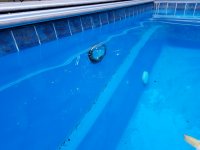When we bought our place in May 2019, the pool light was not working. It would have been installed in 2013. It was a Pentair Amerlite and Amerquartz light niche with an Intellibrite controller.
In May 2020, we made several changes: converted to SWG, installed a variable speed motor/control, changed out the filter sand with glass, and installed a new Intellibrite 5G color led light along with a new Intellibrite controller. The owner of a local pool supply shop has been doing all of our work (until the last week or so, when I started doing my own testing and treatment, thanks to all of you!).
It wasn't long until the shiny parts of the light started turning brown. It looks kind of like rust, but I don't think that's it. If scrubbed enough with a blue woven pad, the shine comes back with no pitting (not the whole thing, some of the stains have resisted all of my scrubbing). And filmy, slimy bits of brown come from the light and float in the pool.
A month or so after the install, we had an inline anode added, per Pentair's recommendation. It's between the pump and the filter. The anode is visible in a clear case, and it's actively anodizing, but the light didn't improve, at least not enough to really tell. I cleaned it over the winter with muriatic acid, so it was fresh again this spring.
Over the winter (with the pool closed), the light got significantly worse. When we had the pool opened this spring, our pool man got Pentair to send a warranty replacement light. A large amount of the brown gunk came out from behind it when it was changed. The new light immediately started turning brown. Looking at it more closely, I don't think it's originating on the front, but coming from behind. The staining and discoloration is notably darker and more scrub-resistant where water is able to move between the front and the back. So far this summer, we don't have any response from Pentair. Because of the effect on our pool water (which may have been due to poor chemistry maintenance, but naturally we're blaming the light), we're ready to have the light yanked and a cover put in its place. The attached image is from last summer, and after a scrubbing. The debris below gives an idea. It looks quite a bit worse now.
Does anyone have a better suggestion?
Thanks for reading and for all the help you've already provided in many other posts.
Jeff
In May 2020, we made several changes: converted to SWG, installed a variable speed motor/control, changed out the filter sand with glass, and installed a new Intellibrite 5G color led light along with a new Intellibrite controller. The owner of a local pool supply shop has been doing all of our work (until the last week or so, when I started doing my own testing and treatment, thanks to all of you!).
It wasn't long until the shiny parts of the light started turning brown. It looks kind of like rust, but I don't think that's it. If scrubbed enough with a blue woven pad, the shine comes back with no pitting (not the whole thing, some of the stains have resisted all of my scrubbing). And filmy, slimy bits of brown come from the light and float in the pool.
A month or so after the install, we had an inline anode added, per Pentair's recommendation. It's between the pump and the filter. The anode is visible in a clear case, and it's actively anodizing, but the light didn't improve, at least not enough to really tell. I cleaned it over the winter with muriatic acid, so it was fresh again this spring.
Over the winter (with the pool closed), the light got significantly worse. When we had the pool opened this spring, our pool man got Pentair to send a warranty replacement light. A large amount of the brown gunk came out from behind it when it was changed. The new light immediately started turning brown. Looking at it more closely, I don't think it's originating on the front, but coming from behind. The staining and discoloration is notably darker and more scrub-resistant where water is able to move between the front and the back. So far this summer, we don't have any response from Pentair. Because of the effect on our pool water (which may have been due to poor chemistry maintenance, but naturally we're blaming the light), we're ready to have the light yanked and a cover put in its place. The attached image is from last summer, and after a scrubbing. The debris below gives an idea. It looks quite a bit worse now.
Does anyone have a better suggestion?
Thanks for reading and for all the help you've already provided in many other posts.
Jeff


